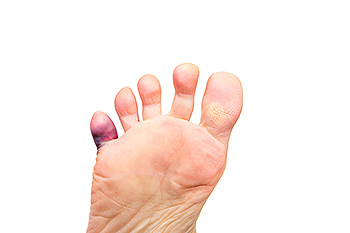Connect With Us
Blog
Items filtered by date: February 2023
A Successful Treatment Method for a Broken Toe

A broken toe is a common injury. The bones in the toe can be easier to fracture than other bones because they are at the end of the body. A toe can be stubbed by a piece of furniture or break from a heavy object falling on it. The medical condition known as osteoporosis is defined as a thinning and weakening of the bones and may be an additional cause of a broken toe. Symptoms often include severe pain, bruising or swelling, and it may become difficult to walk. A severely broken toe might have a bone that protrudes through the skin requiring prompt medical attention. An X-ray is generally performed to determine the extent of the fracture. The buddy-taping method may be implemented for a mildly broken toe. This is done by taping the affected toe to the toe next to it. This can provide adequate support as the healing process occurs. If you have broken your toe, it is suggested that you confer with a podiatrist who can help you with the correct treatment methods.
A broken toe can be very painful and lead to complications if not properly fixed. If you have any concerns about your feet, contact Ronald Pieroni, DPM from Bolingbrook Foot and Ankle Center. Our doctor will treat your foot and ankle needs.
What to Know About a Broken Toe
Although most people try to avoid foot trauma such as banging, stubbing, or dropping heavy objects on their feet, the unfortunate fact is that it is a common occurrence. Given the fact that toes are positioned in front of the feet, they typically sustain the brunt of such trauma. When trauma occurs to a toe, the result can be a painful break (fracture).
Symptoms of a Broken Toe
- Throbbing pain
- Swelling
- Bruising on the skin and toenail
- The inability to move the toe
- Toe appears crooked or disfigured
- Tingling or numbness in the toe
Generally, it is best to stay off of the injured toe with the affected foot elevated.
Severe toe fractures may be treated with a splint, cast, and in some cases, minor surgery. Due to its position and the pressure it endures with daily activity, future complications can occur if the big toe is not properly treated.
If you have any questions please feel free to contact our office located in Bolingbrook, IL . We offer the newest diagnostic and treatment technologies for all your foot and ankle needs.
Pregnancy and Foot Discoloration

When a pregnant woman brings a baby to term, her feet might undergo different and significant changes. For example, during a woman’s pregnancy, she might experience increased swelling in the feet, larger feet, and achy sensations in the feet. One often overlooked symptom of pregnancy is discoloration in the feet. Discoloration is another word for the alteration of color in human skin. Interestingly, discoloration in the skin is a common symptom that some women experience during pregnancy. The feet are certainly no exception to this phenomenon. Specifically, some pregnant women may notice that the soles of their feet have become more red. If you are pregnant or are planning to be, consider contacting a podiatrist today who will help you maintain the health of your feet throughout your pregnancy.
Pregnant women with swollen feet can be treated with a variety of different methods that are readily available. For more information about other cures for swollen feet during pregnancy, consult with Ronald Pieroni, DPM from Bolingbrook Foot and Ankle Center. Our doctor will attend to all of your foot and ankle needs.
What Foot Problems Can Arise During Pregnancy?
One problem that can occur is overpronation, which occurs when the arch of the foot flattens and tends to roll inward. This can cause pain and discomfort in your heels while you’re walking or even just standing up, trying to support your baby.
Another problem is edema, or swelling in the extremities. This often affects the feet during pregnancy but tends to occur in the later stages.
How Can I Keep My Feet Healthy During Pregnancy?
- Wearing orthotics can provide extra support for the feet and help distribute weight evenly
- Minimize the amount of time spent walking barefoot
- Wear shoes with good arch support
- Wear shoes that allow for good circulation to the feet
- Elevate feet if you experience swelling
- Massage your feet
- Get regular, light exercise, such as walking, to promote blood circulation to the feet
If you have any questions please feel free to contact our office located in Bolingbrook, IL . We offer the newest diagnostic and treatment technologies for all your foot and ankle needs.
Are You Suffering From Ingrown Toenails?
Proper Treatment for Ingrown Toenails

There are two common reasons why ingrown toenails may develop. It is a painful foot condition that can occur from improperly trimming the toenails or from wearing shoes that are too tight. It is easy to notice as the nail grows into the skin instead of over it. It is often red and swollen, and may ooze if prompt medical attention is not sought. Temporary relief may be found when the nail is soaked in warm water. This can be followed by gently pulling the affected nail away from the skin. Professional medical advice comes from a podiatrist, who can offer correct treatment methods. This is necessary if the ingrown toenail is severe, infected, or if there are existing medical conditions such as diabetes and circulation problems. If you have developed an ingrown toenail, it is strongly advised that you speak with a podiatrist who can provide adequate treatment, which may include surgery for partial or total nail removal.
Ingrown toenails may initially present themselves as a minor discomfort, but they may progress into an infection in the skin without proper treatment. For more information about ingrown toenails, contact Ronald Pieroni, DPM of Bolingbrook Foot and Ankle Center. Our doctor can provide the care you need to keep you pain-free and on your feet.
Ingrown Toenails
Ingrown toenails are caused when the corner or side of a toenail grows into the soft flesh surrounding it. They often result in redness, swelling, pain, and in some cases, infection. This condition typically affects the big toe and may recur if it is not treated properly.
Causes
- Improper toenail trimming
- Genetics
- Improper shoe fitting
- Injury from pedicures or nail picking
- Abnormal gait
- Poor hygiene
You are more likely to develop an ingrown toenail if you are obese, have diabetes, arthritis, or have any fungal infection in your nails. Additionally, people who have foot or toe deformities are at a higher risk of developing an ingrown toenail.
Symptoms
Some symptoms of ingrown toenails are redness, swelling, and pain. In rare cases, there may be a yellowish drainage coming from the nail.
Treatment
Ignoring an ingrown toenail can have serious complications. Infections of the nail border can progress to a deeper soft-tissue infection, which can then turn into a bone infection. You should always speak with your podiatrist if you suspect you have an ingrown toenail, especially if you have diabetes or poor circulation.
If you have any questions, please feel free to contact our office located in Bolingbrook, IL . We offer the newest diagnostic and treatment technologies for all your foot care needs.
What Is The Medical Name For Sever's Disease?

An inflammation of the growth plate in children and young teenagers may be an indication of Sever’s disease. It can happen as a result of the muscles and tendons growing slower than the heel bone, which may cause pressure and tightness at the back of the heel. The medical name for this condition is known as calcaneal apophysitis and swelling in the heel area may be one of the symptoms. Parents may notice their child is limping or walking on tiptoes, and it is suggested that shoes that fit correctly are worn, preferably with a cushioned heel. Relief may be found when the activity that caused the injury is temporarily stopped, and this can give the child ample time to rest the foot. Some children can benefit from performing specific stretches that are designed to strengthen the heel. If you feel your child may have Sever’s disease, please consult with a podiatrist who can effectively diagnose and treat this condition.
Sever's disease often occurs in children and teens. If your child is experiencing foot or ankle pain, see Ronald Pieroni, DPM from Bolingbrook Foot and Ankle Center. Our doctor can treat your child’s foot and ankle needs.
Sever’s Disease
Sever’s disease is also known as calcaneal apophysitis, which is a medical condition that causes heel pain I none or both feet. The disease is known to affect children between the ages of 8 and 14.
Sever’s disease occurs when part of the child’s heel known as the growth plate (calcaneal epiphysis) is attached to the Achilles tendon. This area can suffer injury when the muscles and tendons of the growing foot do not keep pace with bone growth. Therefore, the constant pain which one experiences at the back of the heel will make the child unable to put any weight on the heel. The child is then forced to walk on their toes.
Symptoms
Acute pain – Pain associated with Sever’s disease is usually felt in the heel when the child engages in physical activity such as walking, jumping and or running.
Highly active – Children who are very active are among the most susceptible in experiencing Sever’s disease, because of the stress and tension placed on their feet.
If you have any questions, please feel free to contact our office located in Bolingbrook, IL . We offer the newest diagnostic and treatment technologies for all your foot and ankle injuries.

